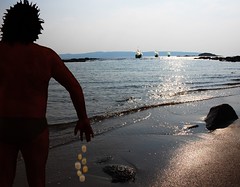This is my attempt to interpret the essence of one of my favourite short poems "The Caravels" written in about 1918.
It's such a simple yet powerfully descriptive poem from the viewpoint of a Native American. I love the man's shock and lack of understanding of how the huge ships are moving - only having been used to little canoes with paddles or oars. But in particular the line "His fallen hands forgetting all their shells" is what I focused on in the image. The forgotten shells of course are a physical symbol of the change about to take place from his old way of life. This is why the shells are emphasised a bit brighter and translucent to the sunlight. Also we are told Columbus landed in morning time - hence the low Sun from the east.
Methodology...
The seashore is not the West Indies but a shot I took in Donegal last year!
The Indian is me in silhouette - with a Halloween mask/wig! Taken indoors recently and added to original.
The shells were collected in Sandycove beach and added later with some computerised movement effects.
The three caravel images were found on the Internet and blended in.
The Caravels - by J. C. Squire
There was an Indian, who had known no change,
Who strayed content along a sunlit beach Gathering shells.
He heard a sudden strange Commingled noise: looked up; and gasped for speech.
For in the bay, where nothing was before,
Moved on the sea, by magic, huge canoes
With bellying cloths on poles, and not one oar,
And fluttering coloured signs and clambering crews.
And he, in fear, this naked man alone,
His fallen hands forgetting all their shells,
His lips gone pale, knelt low behind a stone,
And stared, and saw, and did not understand,
Columbus's doom-burdened caravels
Slant to the shore, and all their seaman land.
Saturday, March 15, 2008
Monday, March 03, 2008
Spring-Time!
My youngest daughter Shona (18) enjoys a few jumps around the garden on Sunday afternoon.
Subscribe to:
Comments (Atom)

